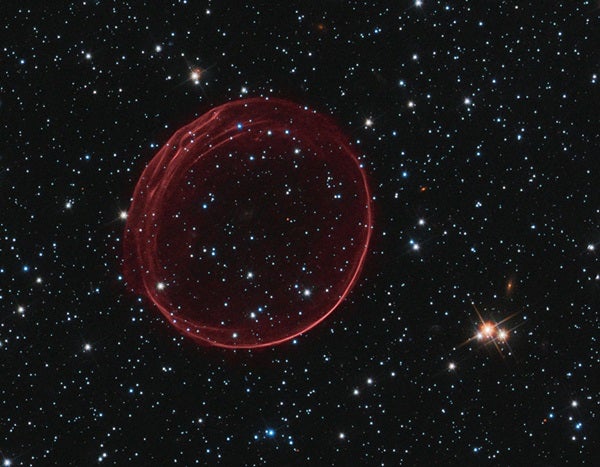The delicate shell, photographed by the NASA/ESA Hubble Space Telescope, appears to float serenely in the depths of space, but this apparent calm hides an inner turmoil. The gaseous envelope formed as the expanding blast wave and ejected material from a supernova tore through the nearby interstellar medium. Called SNR B0509-67.5 (SNR 0509 for short), the bubble is the visible remnant of a powerful stellar explosion in the LMC, a small galaxy about 160,000 light-years from Earth.
Ripples seen in the shell’s surface may be caused either by subtle variations in the density of the ambient interstellar gas or possibly be driven from the interior by fragments from the initial explosion. The bubble-shaped shroud of gas is 23 light-years across and is expanding at more than 11 million mph (18 million km/h.)
Astronomers have concluded that the explosion was an example of an especially energetic and bright variety of supernova. Known as type Ia, such supernova events are thought to result when a white dwarf star in a binary system robs its partner of material, taking on more mass than it is able to handle so that it eventually explodes.
Hubble’s Advanced Camera for Surveys observed the supernova remnant October 28, 2006, with a filter that isolates light from the glowing hydrogen seen in the expanding shell. These observations were then combined with visible-light images of the surrounding star field that were imaged with Hubble’s Wide Field Camera 3 November 4, 2010.
With an age of about 400 years, the supernova might have been visible to Southern Hemisphere observers around the year 1600, although there are no known records of a “new star” in the direction of the LMC near that time. A more recent supernova in the LMC, SN 1987A, did catch the eye of Earth viewers and continues to be studied with ground- and space-based telescopes, including Hubble.
The delicate shell, photographed by the NASA/ESA Hubble Space Telescope, appears to float serenely in the depths of space, but this apparent calm hides an inner turmoil. The gaseous envelope formed as the expanding blast wave and ejected material from a supernova tore through the nearby interstellar medium. Called SNR B0509-67.5 (SNR 0509 for short), the bubble is the visible remnant of a powerful stellar explosion in the LMC, a small galaxy about 160,000 light-years from Earth.
Ripples seen in the shell’s surface may be caused either by subtle variations in the density of the ambient interstellar gas or possibly be driven from the interior by fragments from the initial explosion. The bubble-shaped shroud of gas is 23 light-years across and is expanding at more than 11 million mph (18 million km/h.)
Astronomers have concluded that the explosion was an example of an especially energetic and bright variety of supernova. Known as type Ia, such supernova events are thought to result when a white dwarf star in a binary system robs its partner of material, taking on more mass than it is able to handle so that it eventually explodes.
Hubble’s Advanced Camera for Surveys observed the supernova remnant October 28, 2006, with a filter that isolates light from the glowing hydrogen seen in the expanding shell. These observations were then combined with visible-light images of the surrounding star field that were imaged with Hubble’s Wide Field Camera 3 November 4, 2010.
With an age of about 400 years, the supernova might have been visible to Southern Hemisphere observers around the year 1600, although there are no known records of a “new star” in the direction of the LMC near that time. A more recent supernova in the LMC, SN 1987A, did catch the eye of Earth viewers and continues to be studied with ground- and space-based telescopes, including Hubble.










